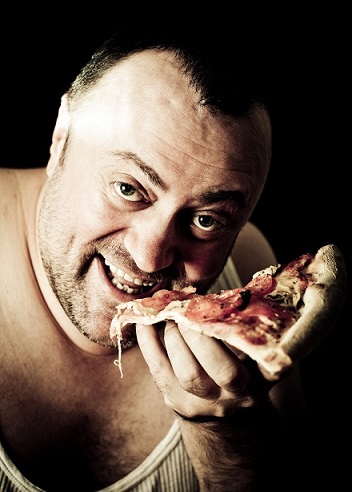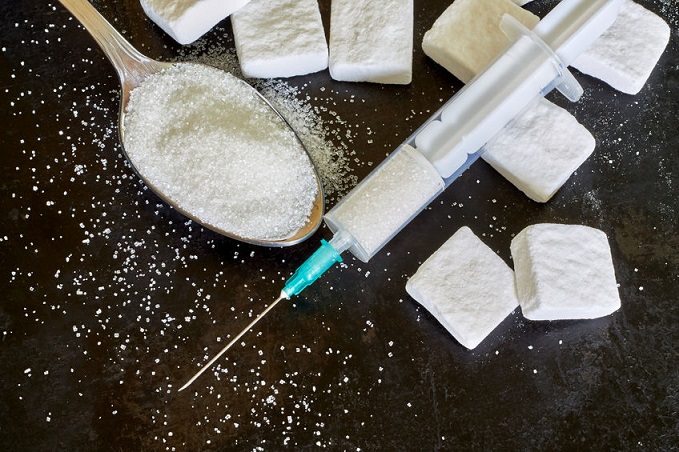 When you’ve got the right knowledge, clearing acne is so simple.
When you’ve got the right knowledge, clearing acne is so simple.
You flush all your sugar down the toilet, throw your pizza out the window like a frisbee, and walk proudly past each and every coffee house with your head held high. The job is done, right?
Unfortunately though, this is easier said than done. We’re not perfectly functioning robots who only have to arrive at global dermatology HQ to get the latest patch of clear skin instructions installed in our brains (although one happy day this might be true).
Discipline is a big question. People can and do fall flat on their faces, and there is no bigger culprit than food cravings.
In April, we discussed why sugar addiction is not a phantom figment of the imagination. Yesterday, we discussed leptin, the easiest satiety hormone to manipulate. Today, we’ll discuss the rest: the endless, murky world of secondary appetite characters.
A word of warning: there’s no concrete set of instructions here. For easy action, visit yesterday’s article. The goal today is becoming an expert, laying down the basic knowledge for when future strategies appear (which they surely will).
Ghrelin – the hunger hormone
After leptin, ghrelin is the second best understood appetite player in the human body.
It was discovered in 1999, and instead of promoting satiety, ghrelin is the only human hormone confirmed to stimulate hunger. A stomach that can’t stop growling (the two words even sound similar), and an unstoppable desire to consume anything offered to you.
When scientists inject mice with ghrelin, they eat more almost without fail. In this study, low doses caused obese people to eat 36% more energy via food from a buffet.
A restaurant and a ghrelin pill is a one way ticket to a kitchen devouring rampage. While leptin is created by fat cells after insulin signals them, ghrelin is released directly by stomach cells. It’s why hunger subsides so fast after your first bite of steak. In studies, people’s subjective feelings of hunger match its waxing and waning very closely. Ghrelin falls in close correlation with calories consumed, but is particularly decreased by protein, followed by carbs and then fat.
Ghrelin binds with GHS-R receptors in the brain, in the appetite-regulating hypothalamus.
Like leptin, its discovery prompted a gold rush of pharmaceutical companies looking for ghrelin inhibitors, but attempts fizzled out for near identical reasons. If it’s the hunger hormone, you’d expect overweight people to be flooded with it, right? Wrong – thin people have high levels, while the obese average lower.
For example, one human study tested a fat-burning bodybuilding diet (most likely chicken, chicken, broccoli and more chicken then). After 6 months, their serum ghrelin rose by 40%. In young women, an exercise heavy weight loss diet increased ghrelin from 770 to 1,322 pmol/liter after 3 months.
Like leptin, it’s believed (though not confirmed) that obese people have malfunctioning receptors – but this time too sensitive. Essentially, a single molecule of ghrelin leads to much more ravenous hunger in fat people.
Ghrelin is also involved with lowering stress, forming bones, building muscle, and human growth hormone release, but its massive role in hunger is exemplified by this study on 8 lean men and 8 lean women. After injecting ghrelin into subcutaneous fat (what little they had), their energy intake rose by 23%.
How can you control ghrelin?
 Compared to the satiety-promoting leptin, the way forward is murkier.
Compared to the satiety-promoting leptin, the way forward is murkier.
For example, leptin resistance is a clear phenomenon: your bloodstream leptin is constantly high, so your receptors downregulate their sensitivity in response.
By eating less for months, falling leptin will allow the receptors to revive, but with ghrelin, there’s no obvious reason for receptor malfunctions. There’s no instant, all encompassing solution. However, the studies do offer some hints…
ONE – sleep better! There’s no logical connection between tossing and turning all night and high ghrelin, but that’s what the studies show. Firstly, when human being slept for 10 hours nightly versus 4, ghrelin rose and leptin plummeted, accompanied by the expected hunger and gnawing stomach. Next, they took it to the next level and made lean humans sleep for 4 hours for just one night. Again, their ghrelin rose, by 23% compared to 7 hour sleepers. Subjective hunger also rose. Evolutionary speaking, sleep deprivation could indicate a crisis situation, like an attack by enemy tribes, compelling you to stock up on fighting fuel.
TWO – eat protein! A big reason why energy bar adverts now boast of “10% more protein” is its growing reputation for satiety. Ghrelin is partially why. Protein decreases ghrelin more effectively than carbs and fats, as shown when 15 men ate a breakfast containing either 58.1% of energy from protein and 14.1% from carbohydrates, or 19.3% and 47.3% (study). The high protein breakfast reduced ghrelin by much more, while also slowing stomach emptying.
This study added fat to the mix, testing 7-11 year olds. They fasted overnight and ate breakfast at exactly 8:00. In both obese and normal children, ghrelin fell gradually yet strongly after a protein-filled breakfast. The carbohydrate group plummeted initially, reaching a nadir at 60 minutes, but then rebounded rapidly – they weren’t satisfied for long.
Meanwhile, the fatty breakfast was inbetween. The carb loaded breakfast came first for ravishing appetite and hunger (not a medal you want to earn), whereas fat and protein were approximately equal. For ghrelin, some recommend eating protein with every meal.
THREE – exercise! If you don’t like the gnawing feeling of ghrelin, then you can simply burn it up (not literally). For example, when 80 men sprinted at maximum velocity for 30 seconds, their ghrelin levels declined and were still below pre exercise levels 30 minutes later. A separate experiment involved either rest for 9 hours, or exercising for 160 minutes and resting for 8 hours. Their ghrelin levels were 38% lower after 3 hours, and 35% lower after 9 hours. It ties in with the athletes to whom “food” sounds like a foreign word, who are so focused on cycling up a mountain pass that a burger doesn’t enter their mind.
FOUR – avoid fructose! A similarity with leptin. Why is a mystery, but one study tested very real processed food villains: a sugar filled drink, like fruit juice or an energy drink. The noble scientists were worried about sugar causing worldwide obesity, so they gave mice either a glucose or a fructose rich drink. The former reduced ghrelin, the hunger hormone, by 30%, but the fructose achieved much smaller reductions. That said, glucose and fructose were indistinguishable in other studies.
Neuropeptide Y
The mothership that all the individual appetite hormones send their signals to. After binding to their brain receptors, both leptin and ghrelin alter neuropeptide Y. Feeding mice neuropeptide Y antagonists can completely abolish the hunger-inducing powers of ghrelin.
Specifically, neuropeptide Y is an appetite-stimulating peptide, made in the brain and concentrated heavily in the hypothalamus, the hunger centre. Ghrelin might be the only hunger fuelling hormone, but NPY is the single strongest appetite stimulator in the human body.
NPY has side roles in energy, metabolism, and fat storage. However, it’s most fascinating role is in stress hunger, where a cranky mood has you grabbing the sweetest chocolate bar you can find.
This includes stressors like cold weather and fighting, with NPY being released by sympathetic nerves. NPY has connections to both epinephrine and norepinephrine, fight or flight hormones released by the adrenal glands.
Neuropeptide Y particularly stimulates the desire for carbohydrates. For example, rats were once presented with a meal for each macronutrient: casein (protein), lard (fat) and sucrose/cornstarch/dextrose. When injected with neuropeptide Y, they uniformly ate more calories, but particularly gravitated towards the carbs. The same happened in 1994 when rats had to chose between carb mania and fat city. Neuropeptide Y could partially explain the endless carb and sugar cravings of acne patients.
STRATEGIES: protein is important once again (a common theme here), as low intakes can boost neuropeptide Y brain production. Scoffing down fiber might also suppress neuropeptide Y, by feeding friendly gut bacteria which send signals to the brain. Compared to leptin, there’s no instant strategy an acne patient can adopt.
Glucogan-like peptide 1
 Here’s where things start getting murkier. NPY, leptin and ghrelin all have clearly defined roles, but now the lines start blurring.
Here’s where things start getting murkier. NPY, leptin and ghrelin all have clearly defined roles, but now the lines start blurring.
Why exactly does the body need so many different satiety compounds? We don’t know, but anyway, glucagon-like peptide 1 is secreted by the gut, in the ileum and colon. It rises after a meal, promoting satiety by sending signals which decrease neuropeptide Y.
For example, healthy men who ate GLP-1 with breakfast were 12% more satisfied (study). GLP-1 has strong connections to insulin and blood sugar – scientists are investigating it as a diabetes drug.
Unlike leptin, your body never becomes resistant to GLP-1. It promotes just as much hunger when injected to obese people. Instead, they produce less of this satiety substance after a meal, and have lower circulating levels overall.
Fascinatingly, levels of GLP-1 rise immediately after gastric surgery. So do peptide YY, discussed below. It’s possible that fat cells directly lower GLP-1 production, sending signals to the colon.
Pharmaceutical giants have already put their noses in, sniffing out the cash, but sadly, GLP-1 has a half life of just 5 minutes in the body. It also makes people nauseous when injected directly. Their latest great hope is a near identical chemical analog called extendin-4, found where else, but Heloderma suspectum, an exotic lizard known as the Gila monster! Unfortunately, extendin-4 also caused vomiting in trials. The word suspectum was probably a giveaway.
STRATEGIES: glucagon-like peptide 1 probably boasts the most fascinating manipulation studies. Firstly, eating leafy green vegetables boosted GLP-1 after 90 days, and the urge for sweets and chocolate plummeted accordingly (study).
Secondly, an oral probiotic boosted GLP-1 using gut bacteria strains which produce butyrate, the short chain fatty acid, giving yogurt or kefir big potential. When scientists mixed butyrate with GLP-1 in a petri dish, it boosted the peptide again.
Finally, GLP-1 is tightly linked to inflammation. Yesterday, we discussed how interleukin-6 weakened the brain’s leptin receptors via generating SOCS-3. Today, it’s tumour necrosis factor alpha (TNF-a) which blocks GLP-1, directly prevent its production by intestinal cells. Like IL-6, TNF-a is an immune system chemical which acne patients have dramatically higher levels of. In their words: “chronic exposure to TNFα directly impairs GLP-1 secretion“. TNF-a can be fuelled by the classic villains of inflammation, like sugar and industrial vegetable oils.
Luckily, I recommend all three strategies for acne anyway. Your appetite might automatically fade away.
Cholecystokinin
Another satiety-promoting hormone. Nobody knows why it’s necessary when GLP-1 and peptide YY already exist, but here’s what we do know.
Cholecystokinin (CCK) levels rise in the bloodstream 15 minutes after eating a meal. It has receptors in the brain called CCKa, and by blocking them with chemicals, scientists have totally abolished its satiety powers. Unlike GLP-1 and peptide YY, cholecystokinin doesn’t increase after gastric surgery. It’s predominantly manufactured in the duodenum and jejunum of the small intestine.
Cholecystokinin has side roles too, but they’re completely different to GLP-1, as low levels have been detected in schizophrenic brains. Which is another point: cholecystokinin particularly accumulates in the brain, hinting that it manipulates satiety neurotransmitters like neuropeptide Y to a huge extent.
Studies look promising; CCK was administered to 8 obese women and 10 lean women intravenously, and the CCK taking women ate much less of a banana split shake. The benefits were similar in the lean and obese women: “under the conditions of this study, CCK significantly decreases food intake in humans“.
Cholecystokinin is particularly increased by fat and protein, rather than carbohydrates, which is important given that high carb diets are the default in today’s civilisation (despite low carb diets being so popular, they’ve made less of a dent than you’d think).
This is probably the murkiest player in the appetite controlling game.
STRATEGIES: we just mentioned protein and fat, and this study found big boosts following a meal of high-fiber beans, versus low-fiber white rice, after fasting overnight. Maybe it was the beans themselves, but maybe it was the fiber, and like GLP-1, the smart guess would be fuelling good bacterial strains which produce cholecystokinin-boosting metabolites.
Peptide YY
 This appetite-decreasing compound has one standout fact: after gastric surgery, it increases in the bloodstream, and can stay increased for decades afterwards.
This appetite-decreasing compound has one standout fact: after gastric surgery, it increases in the bloodstream, and can stay increased for decades afterwards.
Peptide YY is released in the intestines and colon, immediately after eating. Once again, its unique powers (which it must have) are a mystery.
The amount of peptide YY you make is proportional to the calories you eat. After eating a steak, this signaller zaps through your nerves and into the brain receptors of the hippothalamus, where it decreases your hunger and appetite. After eating, bloodstream PYY increases within 1 hour.
Like glucogan-like peptide 1, there’s no paradox here. As expected, peptide YY levels are lower in obese people. Scientists don’t believe that the body can become sensitised to it (unlike leptin). Some theorise that low peptide YY could be a hidden cause of the obesity epidemic. Maybe it’s genes, maybe it’s magnesium deficiency – everything is on the table.
After eating carbs, for instance, your peptide YY suddenly spikes, before crashing to the floor in a heap of hunger and rumbling stomachs. With fat and protein, the peptide can stay elevated for hours afterwards.
As for money-raking schemes (for pure curiosity of course)? A peptide YY nasal spray has been developed, to appetite-busting benefits, but also nausea promoting side effects. Mice have also experienced nausea from direct peptide YY supplements.
STRATEGIES: this, this and this study all supported lowering carbohydrates. The latter was inspired by the principals of the Paleo diet, and PYY shot up rapidly in the 180 minutes post meal. Protein also boosts peptide YY particularly strongly, yet again.
Peptide brings back the fibre strategy and brings it back with style. Butyrate-producing bacteria (which fibre fuels) were mentioned here to boost PYY. This study invented a special digestion resistant fibre called Fibersol-2, and mixed 10 grams into human volunteers’ tea. Their peptide YY and GLP-1 were significantly higher. Even their self-reported satiety rose. Oligofructose, a popular supplemental fibre, was fed to 22 overweight and obese women, and this increased peptide YY and GLP-1, compared to a cellulose-taking placebo group. It didn’t translate to body weight, but that’s no worry – it’s just a single peptide.
Fiber is famously filling, simply because it’s substantial, but there’s also a more subtle, hidden element.
Oxyntomodulin
The newcomer to the appetite-controlling scene. Oxyntomodulin was discovered in 1981, but has only been investigated properly since 2000.
It’s structural similar to glucogan-like peptide 1, even binding to the same GLP-1 receptors in the gut. GLP-1 and oxyntomodulin reduce your gnawing appetite with equal strength, yet confusingly, OXM binds to GLP-1 receptors more weakly. Therefore, there must be extra receptors it binds to, and nobody has identified them yet.
As for the basics? Oxyntomodulin suppresses hunger and like GLP-1, is released immediately after eating and in close correlation with the meal’s calorie count (which is 10,000 if you’re a real man). The power of this molecule is immense, as injecting it into human beings, thrice daily before a meal for 4 weeks, removed 0.45 more pounds per week than a placebo (study). In the first meal, their calorie intake fell by 170, while in the final, it fell by 250. Clearly, oxyntomodulin’s benefits don’t blunt over time. A near identical substance to oxyntomodulin called TKS1225 is now being tested.
A possibly explanation is that oxyntomodulin enhances GLP-1, maybe sensitising the receptors. To be fair, there simply isn’t enough scientists to investigate all these satiety substances now.
Analysis time
Evidently, we now have appetite-controlling knowledge that a caveman could only dream of. So are food cravings and their acne sidekicks finally on the verge of defeat?
With a tidy list of compounds, it’s tempting to imagine adjusting each one with a simple push of a button, from a fat burning switchboard. You might wonder why pharmaceutical companies haven’t exploited these discoveries in an unbeatable diet drug – are they just dumb or what?
Well, just witness the failed craze surrounding leptin drugs. That’s only one hormone, and the best mapped satiety player to date. With multiple satiety players, the complexity rises 10 fold.
We barely understand the individual satiety peptides, let alone the interactions between them. Leptin, ghrelin and neuropeptide Y are the dominant substances, but why does the body need so many smaller ones?
Contradictions are everywhere. For example, ghrelin fell after gastric surgery in one study, but two more showed no differences, and in another two, ghrelin increased.
Peptide YY has loads of promising strategies to jump into. There’s carb restriction, there’s fiber, and GLP-1 has leafy green vegetables. However, if you don’t understand their connection to other appetite compounds then you’re fumbling around in the dark.
Dragging a coherent strategy out of this epic collision of worlds is an act of futility – for now. There will be a strategy in the future, and for now, leptin control is a great starting point.
The rest have many factors common to each other – lowering carbs, eating more proteins, fuelling friendly gut bacteria. In fact, many are problems faced by the average man and woman. You can seize the reigns of your appetite simply by adopting my recommended acne diet.
But that said, it’s still an imprecise art. In ten years, we’ll have surely progressed much further, but probably not far enough – the moment we crack the code of one satiety compound, 10 more spring up in its place.
My bet is that gut bacteria will emerge as massively important. Carbs and proteins are basic though vital stuff. Gut bacteria will be the subtle and complex avenue to explore.
Happily, there are many direct appetite studies covering neuropeptide Y or glucogan-like peptide 1 in isolation. Therefore, there isn’t a hidden derailment scenario where one satiety peptide naturally decreases while the one you’re targeting increases. The raw potential is undoubtedly there.
Conclusion
That’s why today, there’s no complete verdict, no concrete strategy to keep your acne diet on the rails. We simply don’t have enough information yet, but there’s still plenty you can do.
For now, leptin should be a focus, as covered yesterday. That includes restricting carbs, controlling chronic inflammation, and dodging lectins like in wheat.
Sleeping well is a fantastic instant fix for your hunger hormones – their ghrelin went out of whack in just one 4 hour night. Additionally, see here: sugar addiction is a very real problem.
I recommend all those strategies for acne anyway. However, simply knowing the names of these satiety compounds will add a new layer of wisdom to your master plan. You’ll finally realise which substances which have been holding you back.
During the depression of sugar withdrawals, you’ll know that it isn’t the forces of giving up and inevitability conspiring against you; it’s simply the leptin receptors in your brain being starved. You’ll know that by seeing the operation through, true diet control will be within your grasp.
Learn the ways of appetite manipulation, and your dream of clear skin will move one step closer.
Thanks for reading!
